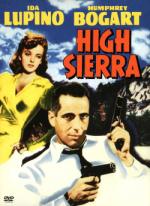High Sierra
 Year:
Year: 1941
Film Studio: Warner Bros. Pictures, First National Pictures
Genre: Crime, Classic, Drama
Length: 100 Min.
DirectorRaoul Walsh (1887)
WritingJohn Huston (1906)...Screenplay
W. R. Burnett (1899)...Screenplay
W. R. Burnett (1899)...Novel
ProducerMark Hellinger (1903)
Hal B. Wallis (1899)
CinematographerTony Gaudio (1883)
MusicAdolph Deutsch (1897)...Composer
StarsIda Lupino (1914) as Marie
Humphrey Bogart (1899) as Roy Earle
Alan Curtis (1909) as 'Babe'
Arthur Kennedy (1914) as 'Red'
Joan Leslie (1925) as Velma
Henry Hull (1890) as 'Doc' Banton
Henry Travers (1874) as Pa
Jerome Cowan (1897) as Healy
Review The year 1941 is primarily remembered for the infamous attack by the Japanese on Pearl Harbor that finally brought the United States into World War II, but to film lovers, this year marks the beginning of Humphrey Bogart’s ascent to the mantle of star supreme at Warner Brother’s pictures. During the thirties, Bogart was typecast in the role of double-crossing sleaze ball villain in some of the great gangster films made by James Cagney, Edward G. Robinson and George Raft. When Raft turned down the starring role in Raoul Walsh’s upcoming gangster film
High Sierra, Bogart was given the chance to prove that he had the screen presence necessary to carry a picture. While Cagney’s and Robinson’s career’s would be slightly derailed and Raft’s virtually extinguished in the forties, Bogart’s would blaze brightly with the rapid repetitive success of not only
High Sierra, but also
The Maltese Falcon that same year, and of course
Casablanca (both film roles rejected by Raft) in 1942.
In
High Sierra, Walsh would break the mold most commonly used in other gangster pictures of the era, by showing another side of Bogart’s character Roy
‘Mad Dog’ Earle. Instead of only portraying Earle as an unrepentant and incorrigible criminal, he allows Bogart to add a little compassion to his ruthless character. It is this bit of humanity that will bring an end to his lawbreaking life and serve up a heaping helping of the doctrine of the day that
‘crime doesn’t pay’. The anti-hero would become more popular in the counter-culture of the sixties and most of the credit for this twist in storytelling would be lauded upon the directors and actors of that time, even though this was the first film to feature this departure from the norm.
High Sierra is a riveting drama that would also being a springboard for three other actors who were just starting off in Hollywood. Arthur Kennedy and Cornel Wilde, who play two members of Earle’s gang, would go on to have distinguished careers in the late forties and early fifties in a number of classic films. The female lead Ida Lupino, who at times steals key scenes from Bogart, would go on to become one of the first successful female directors in Hollywood. She would break down the invisible wall of chauvinist dogma that precluded others of her sex from achieving success in this most important position in filmmaking.
If you are a fan of gangster movies than this film will surely satisfy, it is one of the last great movies made in the gangster genre. Its strengths are apparent, it is not over burdened with clichés, the acting is topnotch and the pacing is taut. As the country plunged itself into the Second World War and the films of Hollywood became more patriotic and propagandist, the once glorious gangster film would slowly ebb away and would be re-awakened in a new format, film-noir.
Ratings Criterion5 Stars - The pinnacle of film perfection and excellence.
4 ½ Stars - Not quite an immortal film, yet a masterpiece in its own right.
4 Stars - Historically important film, considered a classic.3 ½ Stars - An entertaining film that’s fun or engaging to watch.
3 Stars – A good film that’s worth a Netflix venture.
2 ½ Stars - Borderline viewable.
2 Stars – A bad film that may have a moment of interest.
1 ½ Stars – Insipid, trite and sophomoric, and that's its good points.
1 Star – A film so vacuous, it will suck 2 hours from the remainder of your life.
½ Star - A gangrenous and festering pustule in the chronicles of celluloid.